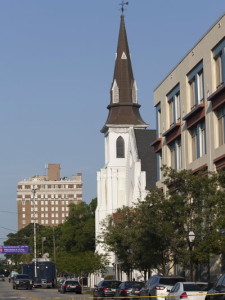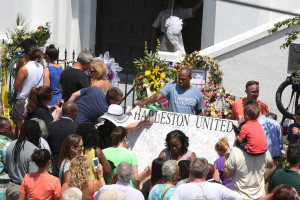The coverage of the Charleston Massacre, in which nine African American parishioners were gunned down during Bible study by a white man on June 17,2015, has been notable for its references to the cultural landscape of the killings. Here a variety of reporters for the Washington Post and the New York Times describe Charleston in terms that strike a chord for someone interested in museums, cultural heritage, and interpretation:
- The current building is white, and imposing, with a tall steeple and a 100-year–old pipe organ. Emanuel is a rare black landmark in a historic downtown that has been—for tourist purposes—frozen at the peak of white Charleston’s historic power and influence, on the eve of the attack on Fort Sumter. Robert Costa, David A. Fahrenthold, Sarah Kaplan, Janell Ross, Anne Gearan. Washington Post, Friday June 19, 2015.
- Emanuel Church sits on the edge of a neighborhood that offers “adventures of historic proportions” according to the local tourism bureau. Here, the Old Slave Mart stands as a testament to a time when people sold other people for use as animals. The last sale of slaves took place there 152 years ago. You can visit today for $7….. Now, the pastor welcomed the stranger into his church. A white visitor at Bible study was no ordinary event. Church in Charleston, as in most of the nation, is a time when people tend to stay with their own. Emanuel Church is on a street where, for decades, blacks were restricted to one sidewalk; the other one was whites-only. Chico Harlan, DeNeen Brown, Mark Fisher. Washington Post, June 20, 2015.
- The Confederate flag still flies at the state capitol in Columbia, SC. Black people across the South live on streets named for heroes of the side of the Civil War that opposed the end to slavery….Greg Tate, a black writer and musician, said black people could not help but feel that they are under siege in a society afflicted with amnesia about its own history. Lydia Polgreen New York Times June 21, 2015.
I’ve written about what these journalists are picking up on. I call it “institutional body language.” As with personal body language, the institutional version conveys the non verbal and (sometimes) unconscious and unintended messages that museums and other cultural organizations communicate through their architecture, the images they select for their publicity, the staff who greet visitors on the floor, etc. What these reporters have noticed is just that – the atmosphere, the unspoken but powerful messages conveyed not only by what is emphasized (Charleston at the height of its white supremacist influence), or what is preserved rather than placed in context (the Confederate flag, street names), but by what is left out entirely.
In their recent thought-provoking book, Cities, Museums and Soft Power, Gail Dexter Lord and Ngaire Blankenberg (AAM, 2015) write of the ways in which museums are increasingly in a position, as respected civic institutions, to wield influence (soft power) regarding the economic and social development of their communities. As one manifestation of soft power, Lord and Blankenberg write that museums have the potential to move from being “landmarks to place makers.”
We distinguish two very different roles for museums in the built environment of cities: as landmarks and as place makers. As a landmark, the museum building brands the city or the neighborhood…. In this era of power diffusion, museum buildings are more than landmarks. They are also cornerstone in successful place making. Place making refers to the interactions between people and place in the creation of social capital (the capacity of people working together to solve problems….Because this is an interpreted space –a place with assigned meanings—we may also be challenged to see things in a new way….
A city’s anchor institutions are those that have proven to be sites of community sustainability, such as hospitals, universities, libraries, community centers, places of worship and museums. The value of anchor institutions is to preserve memory and to adapt the knowledge of the past to changing contexts. [They] accumulate a body of knowledge … and engage with the public ….These anchor institutions are challenged to develop new ways of organizing such knowledge, reflecting changes in the origins of knowledge and the ways in which it has been collected. Museums as anchor institutions exercise soft power based on community participation…museums exist within an Internet-facilitated culture of stewardship in which transparency and the inclusion of multiple voices is critical to achieving soft power. Lord and Blankenberg, 20-22. (Emphasis mine)
I’ve never been to Charleston. A Google review of its “Museum Mile” and of other tourist information shows that African American history and historic sites are not entirely absent from the cultural landscape. Some museums feature exhibitions illustrating the contributions of African Americans to Charleston history. An International African American Museum is set to open in 2018. Yet, the perspective of the reporters quoted above suggests that the preponderant interpretive messages communicate only a part of Charleston’s historic legacy. Could Charleston’s “anchor institutions,” among them museums and places of worship such as Emanuel, collaborate to shape a new vision of the city, one that is more inclusive and that reflects to a greater degree the historic importance of black as well as white Charleston? The current apparent racial unity of Charleston, as evidenced by the interracial participation in all of the events commemorating the massacres at Emanuel Church, cannot be a temporary, emotional response to that terrible event. It seems to me that Charleston museums and other “anchor institutions,” including Emanuel and other African American organizations in the city could help sustain racial healing through collaborative effort. I’m in no position to know what kind of bridge-building must precede this collaboration; perhaps it has already begun. In previous posts we’ve looked at the modalities and challenges of the #museumsrespondtoFerguson initiative. Changing the “institutional body language” of Charleston seems a worthy contribution to the issues raised by Ferguson writ large.
What about the “institutional body language” of your city and its historic sites and museums? How can your anchor institutions wield soft power?
If you are reading this post as an email, you can comment by going to www.museumcommons.com. Or by sending me a tweet @gretchjenn.


Pingback: When do we edit participation? | Museum Questions